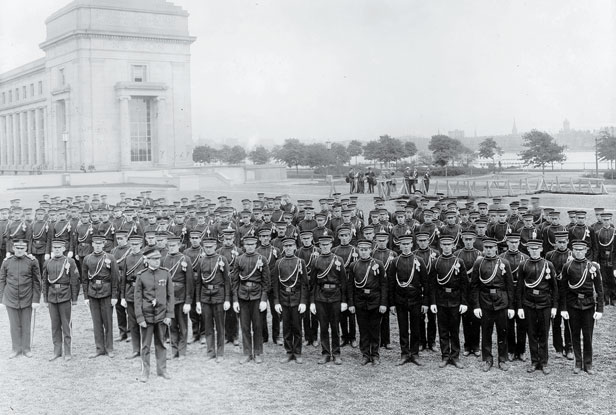
In 1892, it was not uncommon to see MIT freshmen hustling along Boston’s Irvington Street, fastening buttons and straightening collars, on their way to the South Armory to pick up their rifles to assemble, uniformed and armed, for their weekly military drill instruction at 2:20 p.m.
Under the Morrill Land-Grant Act of 1862, signed into law by Abraham Lincoln, each state in the Union had been provided federal land for colleges focused on agriculture, science, and engineering. These schools had to include mandatory military training in the curriculum. Although MIT was founded in 1861, the Civil War delayed its opening, and in 1863 the Institute was designated a land-grant college. So when the war ended and MIT held its first classes in 1865, military instruction became a part of freshman life.
If anyone wanted to see the military taken seriously at the Institute, it was Harry Hawthorne, an army lieutenant who took charge of Tech’s military department in 1892 after serving in the campaign against the Lakota and at Wounded Knee, where he was injured and earned the Medal of Honor. But upon arriving at MIT he found himself in charge of “a poorly drilled battalion of freshmen, with worn-out, disgraceful equipments, no organization except for drill purposes and no system of administration whatever.” In June of 1893, looking back on his first year as professor of military science and tactics, he was dismayed at the dearth of records for the program; he couldn’t even find out who all his predecessors had been. Lamenting the school’s seeming disregard for his program, he took it upon himself to commit the history of the department to paper. Regarding the beginnings of its “ill-starred course,” he wrote, “The whole aim, object and intention and desire of the authorities of the school at that time [1865] in introducing the travesty they called a Military Department was solely, and I suppose, undisguisedly to get possession of the few thousand dollars dangling at the end of the Act of Congress of July 2nd, 1862.”
Hawthorne addressed many of the department’s problems. When students made excuses for why they couldn’t get to morning drill on time, he moved it to midafternoon. When winter came, he persuaded the MIT administration to heat the building where drills were held. And he designed a detailed course in military theory, lecturing on the construction and use of common weapons, varieties of gunpowders, military strategy, and the organization and history of the U.S. Army.
But Hawthorne met with resistance. He added a lecture series in military topography to Course I, only to see the length of the series cut in half the next year—making it less than useless, in his view. He asked to start a volunteer battalion of sophomores, but MIT wouldn’t allow it. Finally, after what he perceived as a series of further insults—including a deeply unflattering portrayal of him in Technique—he resigned on September 1, 1894, leaving MIT for what would be a distinguished military career.
Things got worse after he left. In October 1899, the freshman class hanged their drill instructor, Lt. Hamilton, in effigy. A month later, they padlocked the genuine article inside the drill hall while upperclassmen cheered; his rescue required a locksmith. The students remained unruly until their instructor refused to make any further attempt to teach them—at which point the faculty publicly chastised the Class of 1903.
According to a Boston Daily Globe article about the fracas, Hamilton, a recent West Point graduate, was “as popular as a Tech drill-master could be.” The students’ ill behavior was not directed at him personally but, instead, reflected their dislike of the mandatory military training—something they saw as a waste of time.
Shortly after the passage of the National Defense Act of 1916, which created the ROTC program, the Department of Military Science and Tactics was disbanded. In 1917 it was replaced by MIT’s new army ROTC unit, the Paul Revere Battalion. Military training at MIT would become mandatory for freshmen and sophomores and remain so until 1958.
Although military training is no longer compulsory at MIT, the school’s connection to the military remains strong. The Paul Revere Battalion is one of the nation’s oldest ROTC units, and MIT’s research contributions to the military are innumerable. At the start of the 20th century, MIT president Richard Maclaurin wrote, “[If] war is to remain a possibility we must face the fact that it will tend more and more to be a war of applied science, and the nation that does not take that lesson to heart by training men to apply science to war-like ends should necessity demand such an application will surely go down in the next great conflict.”
Keep Reading
Most Popular
Large language models can do jaw-dropping things. But nobody knows exactly why.
And that's a problem. Figuring it out is one of the biggest scientific puzzles of our time and a crucial step towards controlling more powerful future models.
The problem with plug-in hybrids? Their drivers.
Plug-in hybrids are often sold as a transition to EVs, but new data from Europe shows we’re still underestimating the emissions they produce.
Google DeepMind’s new generative model makes Super Mario–like games from scratch
Genie learns how to control games by watching hours and hours of video. It could help train next-gen robots too.
How scientists traced a mysterious covid case back to six toilets
When wastewater surveillance turns into a hunt for a single infected individual, the ethics get tricky.
Stay connected
Get the latest updates from
MIT Technology Review
Discover special offers, top stories, upcoming events, and more.